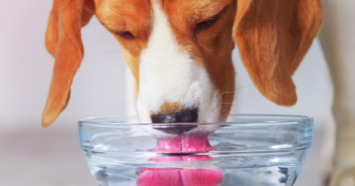
Ever find yourself wondering why your well-housebroken adult dog is having accidents in the house or can no longer make it through the night without a midnight potty break? The onset is often subtle, but many people find their aging pets must be walked more frequently or an increase in the number of urine piles in the litter box. After paying closer attention, you may realize that you are filling the water dish more frequently too. Perhaps your pet is even seeking out water in unusual places such as lapping up standing droplets in the shower or puddles outside.
Increased thirst (polydipsia, or PD) and excessive urination (polyuria or PU) often go hand in hand (abbreviated as PU/PD). While accidents in the house are harder to miss, they may unfortunately be written off as part of the aging process or a frustrating behavior change. Increased thirst often goes unnoticed, especially in a household with more than one pet. Don’t assume changes in water consumption and urination patterns are a normal aging change; they can be early signs of many clinical diseases and warrant a medical investigation.
Causes
In aging felines, common causes of polyuria and polydipsia are kidney disease, diabetes mellitus, and hyperthyroidism. In dogs, common causes include diabetes mellitus, diabetes insipidus, hyperadrenocorticism, and kidney disease. There are less common causes such as rare psychogenic disorders, pyometra, and even low protein diets. Some medications also cause this, such as commonly prescribed glucocorticosteroids and diuretics.
Diagnosis
A thorough medical history and physical exam are especially important in the diagnosis of PU/PD in our pets. The physical exam may reveal evidence of underlying disease, but diagnostics will be needed.
Your veterinarian will likely start by performing an invaluable and relatively inexpensive test known as a urinalysis, or a urine test. The best time to collect a urine sample is in the morning during the pet’s first potty break. This is because the urine is more concentrated as sleeping pets drink less at night. Your veterinarian will decide if a “caught” urine sample or one via needle, known as cystocentesis, is best. Urine collected by cystocentesis provides a sterile sample that is not contaminated with bacteria on the skin or in the lower urinary tract so this is the reason for the two different collection methods. Cystocentesis collection often involves a brief ultrasound of the bladder for accurate collection. While this provides valuable information about the bladder’s appearance, it is not always necessary.
In addition to the urinalysis, a serum biochemistry panel with electrolytes, and a complete blood count will likely be needed. Based upon the results, radiographs or additional testing for specific diseases may be recommended.
Treatment
Urinary incontinence, inappropriate urination, and frequent urination can be frustrating for pet parents. Remember, excessive urination and drinking are not illnesses but symptoms of many diseases. The appropriate treatment depends upon the underlying cause. Fortunately most of the diseases that cause these symptoms can be medically managed or even cured sometimes.
If you suspect your dog or cat is drinking more, urinating more, or urinating in abnormal locations, talk with your veterinarian to see if a medical workup is warranted.